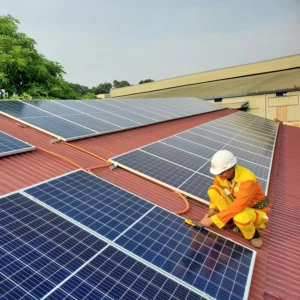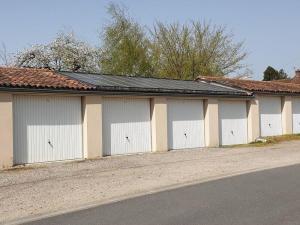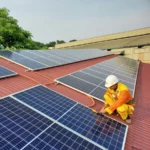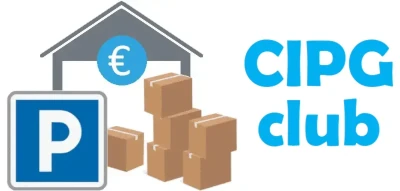📑 Table of contents

Installing photovoltaic solar panels on your roof
What is photovoltaic energy ?
Photovoltaic panels generate electricity from the sun’s rays. Photovoltaic cells made from silicon transform sunlight to create a direct current. An inverter transforms the direct current into alternating current. The electricity produced can be used locally or fed into the electricity grid.
Advantages of solar panels
There are several reasons why individuals and businesses are turning to solar panels :
- Ecology :
Photovoltaics is a sustainable energy source because it does not emit any greenhouse gases into the atmosphere. Its impact on the environment remains low, apart from the difficulty of recycling solar panels at the end of their life. Companies are investing in solar energy in order to project a positive ecological image.
- Low maintenance costs :
Once the system has been commissioned, the annual maintenance costs are very low. It is estimated to cost around 1% of the value of the investment per year. Maintenance consists of cleaning the solar panels to maintain correct yields, and checking the electrical equipment is also recommended.
- Service life :
Solar energy is a long-term investment. A new photovoltaic installation has a lifespan of more than twenty-five years.
Disadvantages of photovoltaics
- High investment :
The cost of installation remains high, since a complete high-quality system is sophisticated. If you find cheap solar panels, read the scam section below. Although the system will pay for itself within a few years of installation, the initial investment is a major drawback. If you take out a loan, you’ll need to include it in the calculation of your financial return to see whether your project is viable and economically viable.
- Variable return :
A solar panel’s energy output will drop when it’s raining or when the sky is cloudy. The efficiency of solar installations also depends on the quality of the panels installed – not all solar panels have the same output. Electricity production is affected by the ageing of the panels, and time is a factor that reduces the performance of an installation. An installation that is 10 or 15 years old will no longer have the same performance as when it was first installed.
Two solutions to make your roof profitable
Roof rental
The most attractive solution on paper is to lease the roof to a company that will operate it by installing solar panels. In this case, the building owner signs a long-term lease with a professional player in the market. An emphyteutic lease is a long-term rental contract, and for solar panels the commitment is 20 to 30 years.
The advantage for the owner of a leased roof is that there are no installation costs. They don’t have to worry about energy production, and they don’t have to bear any operating or maintenance costs for the equipment.
There are three disadvantages to renting out a roof : a small income, additional insurance and a long lease. Energy income is shared between the owner and the installer, who rents to an operator. As the owner has not invested any money, he will only receive a small rental income. Another point to bear in mind is building insurance. The owner will have to amend his insurance policy to cover part of the photovoltaic installation. The final negative point is the 20-30 year commitment via an emphyteutic lease. In the event of resale, the new buyer may feel constrained by buying a property with this constraint.
There are two types of remuneration for the owner of a building who rents out its roof. The first option is to receive a substantial sum when the long lease is signed, but nothing more for the next 30 years. The second option offers a monthly, quarterly or annual income for the duration of the lease.
Investment : being a player and producer of energy
The second option is to invest in the energy transition. You finance the installation of solar panels on your roof. In this case, you are free to choose, with no contracts to interfere with your electricity production. Several banks are willing to finance a photovoltaic installation, so you can leverage your investment to combine ecology and passive income.
As the sole owner, you sell your electricity production to the biggest player in the sector. We recommends to sign a 10 to 15 years contract to sell your electricity production overhang. A special system allows you to feed all or part of your energy production into the ENEDIS network.
5 points to check before taking the plunge
Roof orientation
Before thinking about the system you’re going to install, you need to check that your roof is properly oriented. There’s no mystery about it : to produce electricity, a solar panel needs to capture as much sunlight as possible. You can choose to have your roof face east to west, although south-facing is still the best option.
Roof pitch
Another important factor is the angle at which your roof is tilted. Studies show that the ideal pitch for solar panels is between 30 and 45 degrees. If your roof has a steeper or shallower pitch, you won’t necessarily get a good energy yield. As a result, the electricity you produce could reduce your project to an unprofitable investment.
Sturdiness of the framework
The last technical point that needs to be checked concerns the structure of the building. Electricity-generating equipment weighs a certain amount, so your roof structure must be solid enough to support the installation. Only a mechanical resistance study can determine whether your roof is strong enough, but real professionals are quick to spot any inappropriate situations.
Freehold or co-ownership
Before embarking on a photovoltaic project, you need to know whether you own the roof of your property. Full ownership means that you are the sole owner of a building. As sole owner, you are free to carry out the work as you see fit. Co-ownership means that a building is shared between several people. Decisions to carry out work are taken at a general meeting of co-owners, and the roof often belongs to the co-ownership. It’s more difficult to get solar panels installed when you’re a co-owner.
Roof surface
The size of the project is important: it’s not the same thing to equip a battery with a few garages or the entire roof of a warehouse. For small-scale projects, we consider that at least 80 m² of roof area is needed for an investment project to sell electricity on to be profitable. In our case, we’re talking about creating income from electricity production. For a house used for self-consumption with resale of surplus production, the return on the project and the objectives to be achieved will not be the same.
In the case of a large roof, by installing panels on the roof of a warehouse. Additional income skyrockets. The more solar panels you install, the more electricity you produce. Opting to rent out your roof is a good way of generating a quick income.
If you opt to invest in roof-top installation, the surface area to be equipped will have a major impact on the installation budget. You need to study the project carefully and arrange bank financing if necessary. On a large roof surface, the yield of a photovoltaic installation is between 10 and 12% gross, although this estimate varies according to a number of parameters (roof slope, south-facing orientation, with high sun exposure).


Self-consumption or total resale
Partial or total self-consumption
We talk about partial self-consumption when your photovoltaic installation produces electricity for your personal use (home) or professional use in the case of a factory. Self-consumption means storing the energy produced when you are not using it, so your installation must be equipped with batteries. It is total when the installation is large enough to meet your consumption, in which case the surplus can be fed back into the electricity grid and generate income. This configuration helps to reduce your electricity bill, although its installation needs to be carefully studied to ensure the best possible return on investment.
Total resale
The producer chooses to sell all the electricity produced by the solar panels. This is a yield-oriented strategy designed to generate maximum income from energy production. In France, for example, the Commission de Régulation de l’Électricité (CRE) sets the resale price per kWh.
⚠️ Beware of scams 📢
Free or 1 euros solar panels
Promising advertisements announce solar panels free of charge or for a token 1 euros, or even an installation fully funded by the state or your local council. This is currently the most common scam. In most cases, these solar panel scams are consumer loans disguised as high-interest loans. There is help available in the form of subsidies, such as the self-consumption bonus.
Disguised credit
Energy-efficient renovations often conceal a financing offer. In reality, the homeowner will be taking out a disguised consumer loan with very high interest rates and/or a very long loan term. You need to pay close attention to the terms and conditions of the loan offered by the organisation installing the solar panels.
Telephone or door-to-door canvassing
Telephone sales are the scourge of modern times. The number of calls concerning energy renovation or the installation of solar panels is just incredible. In any case, you should avoid signing a contract with a company that uses telephone canvassing or door-to-door sales methods. Reputable companies that are supposed to be partners don’t need to canvass to sell. In fact, door-to-door canvassing is now prohibited by law.
Trade fairs
Be very careful at trade fairs and shows, which are dangerous places for consumers. The 14-day right of withdrawal does not apply, and signing a contract commits you immediately. Never sign a contract for a photovoltaic installation at a trade fair or exhibition – take your time and think it over. An exceptional offer will remain valid after the event if the seller is honest.
Conclusion : good or bad idea
Photovoltaics is still a good idea for creating passive income, if the whole project is economically viable. The idea of equipping an unused roof to rent out or install solar panels can be profitable. This type of project should be avoided unless you have a large number of garages or a roof area of more than 80 square metres. Take the time to calculate the return on your investment. You need to weigh up the cost of the operation against the return on investment.
You will soon be able to read our detailed study on this subject. We have compared two photovoltaic installation projects: cost of the work and estimated income.
🔐 Access restricted to club members.

💰 Create and boost your passive income
Property news
1 mail per month
+5000 subscribers
